Imagine stepping onto a warmly inviting floor on a chilly morning—this is the luxurious reality of radiant floor heating.
Radiant underfloor heating, often simply referred to as underfloor heating, seamlessly integrates comfort and efficiency beneath the very floors you walk on. In this detailed article, we delve into the various types of radiant heating systems, examine their benefits and limitations, and identify the best spaces for their installation.
Key points:
- Unpack the essentials of radiant floor heating and its distinct advantages over conventional central heating systems.
- Compare electric and hydronic radiant systems to determine the best fit for your home.
- Pinpoint the most suitable rooms for installing radiant floor heating to maximise comfort and value.
What is Radiant Underfloor Heating?
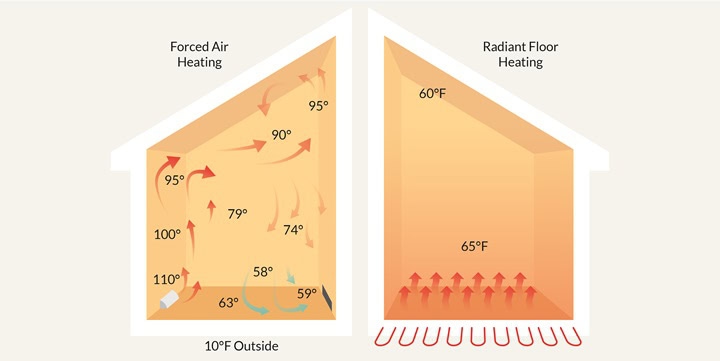
Radiant floor heating, or radiant underfloor heating, revolutionises home comfort by distributing heat uniformly across entire floors. Unlike traditional heating systems, such as radiators where only a certain amount of heat can be transmitted across each room, creating uneven warm and cold spots in the process, a radiant heating system is simply added directly under your floor surface, providing consistent warmth from below.
Radiant Floor Heating Types
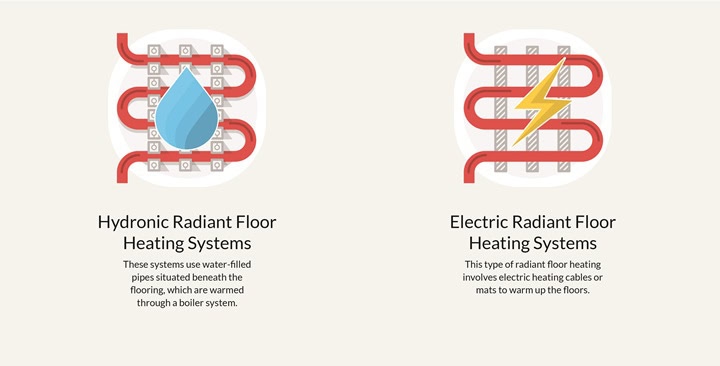
Radiant underfloor heating comes in two main forms: hydronic (water-based) and electric.
- Hydronic systems circulate heated water through pipes beneath the floor, making them efficient for whole-house heating.
- Electric radiant floor heating systems use electrical cables to generate heat and are often preferred for smaller areas due to being easier to install.
Hydronic radiant heating is notably more cost-effective over time, with operational costs up to three times less than those of electric systems, though the initial setup is more expensive. This distinction helps homeowners decide based on their long-term heating needs and initial budget.
For a better understanding, check out the table below:
| System Type | Compatibility | Installation Price | Running Cost | Timing |
| Hydronic Radiant Heating | Suitable for all homes. Best for new builds, renovations, off grid homes. | Higher up-front cost. | Low in the long term. | Variable depending on size of project and chosen system. Contact us for more info. |
| Electric Radiant Heating | Suitable for all homes. Better in smaller spaces e.g., bathrooms, loft conversions, etc. | Cheaper to install than hydronic. | Costs 3x greater than hydronic. | Depending on room size, can be done in a few hours. |
Radiant Floor Heating vs. Radiators
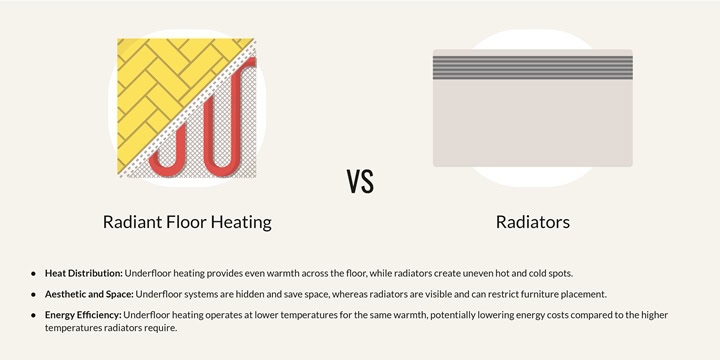
Traditional radiators (wall heaters) work by heating air directly around them, creating uneven temperature zones within a room. This often results in hot spots near the radiators while leaving other areas uncomfortably cool unless the heat is significantly increased, potentially raising energy costs.
Radiant underfloor heating systems, however, deliver a more uniform distribution of heat across entire rooms from the floor upwards. Radiant underfloor heating usually operate at 25-30°C, compared to radiators which typically require 60-80°C to heat a room effectively, thereby reducing your carbon footprint as well as energy bills.
Radiant heating is versatile too; it doesn’t need to replace radiators entirely as both systems can be used to maximise efficiency and comfort.
Floor Coverings
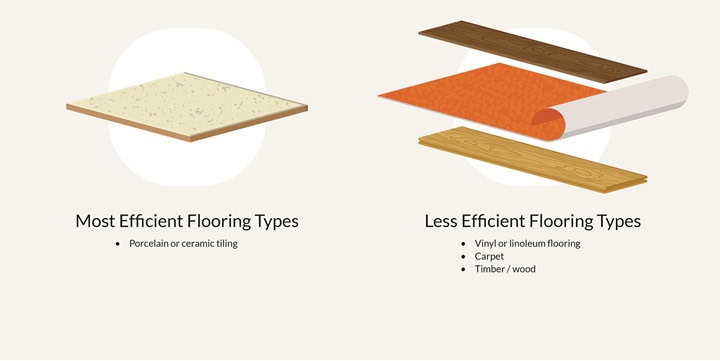
The choice of floor covering is critical in maximising the efficiency of radiant floor heating. Ceramic tiling is often the preferred choice due to its excellent heat conduction properties and ability to retain warmth. However, other materials like vinyl, linoleum, carpeting, and wood are also compatible, provided they are used appropriately.
For instance, for carpets, it should be thin with dense padding to allow heat to permeate effectively. Similarly, when using wood, engineered wood flooring is recommended over solid wood to prevent the material from shrinking and cracking due to the heat.
In rooms where different floor coverings are used, it may be better to install separate tubing loops. This ensures that areas with insulating coverings, like carpet or wood, receive sufficient heat without overheating rooms with more conductive materials like tile.
For the specifics on heating with different flooring types, try these articles on our blog:
- Find out about the best flooring for underfloor heating.
- Basement flooring: which underfloor heating system is better?
- Is vinyl flooring with underfloor heating the ideal choice? Find out now.
- Learn why porcelain or ceramic tiles are the preferred choice is underfloor heating.
Benefits of Radiant Floor Heating
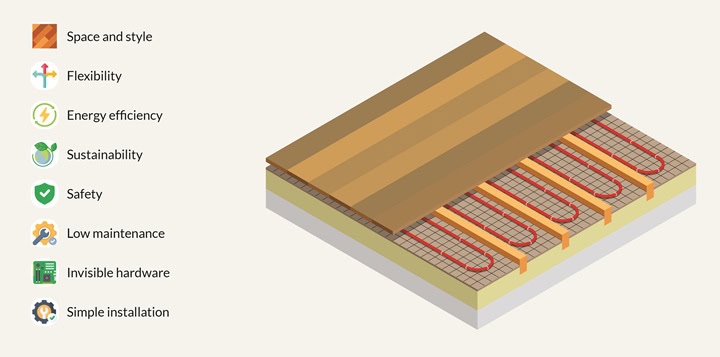
Here are the key benefits that you can experience with radiant underfloor heating:
- Space and style: Unlike bulky radiators, radiant underfloor heating fits invisibly beneath your floor, freeing up walls and living space.
- Flexibility: These systems are incredibly versatile, suitable for installation in any room of your house—whether it’s a new build, an extension, or a renovation project, as well as different flooring types.
- Energy efficiency: Radiant floor heating is up to 25% more energy-efficient than traditional radiators. When adding ground source heat pumps with underfloor heating, the efficiency can increase to 40%.
- Sustainability: By operating more efficiently, electric radiant floor heating systems help reduce your home’s carbon footprint.
- Safety: The design of radiant heating systems eliminates the hazards associated with radiators, such as sharp edges or hot surfaces, making them safer for households with children or elderly members.
- Low maintenance: Radiant floor heating systems require minimal upkeep. They can be effortlessly controlled via smart thermostats, which adjust heating schedules and temperatures to suit your daily routine.
- Invisible hardware: Unlike HVAC systems and radiators that can emit noise during operation, radiant systems offer a quiet and peaceful environment.
- Simple installation: Electric radiant heating can be installed in a matter of hours, and is a preferred option for those wanting to do it themselves.
Drawbacks of Radiant Floor Heating
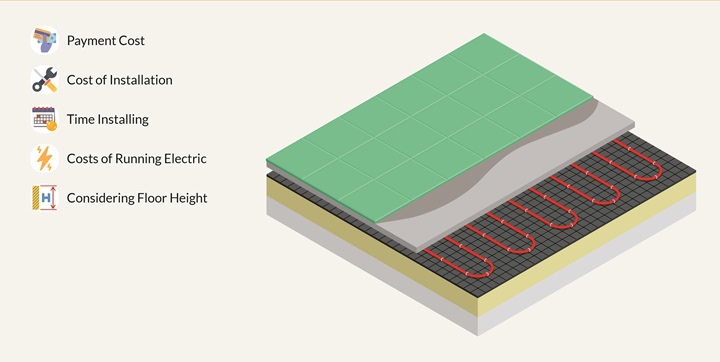
While radiant underfloor heating has many benefits, it’s important to consider these drawbacks before choosing it:
- Payment Costs: Installing radiant underfloor heating can be quite the investment, especially in larger homes or during renovations.
- Cost of installation: The installation process itself can be complex and time-consuming, and it is recommended to hire a professional to carry out the process instead, which can add to an already heft cost alongside purchase of the system itself.
- Time Installing: Electric radiant floor heating systems tend to have higher operational costs than their hydronic counterparts. This makes them less ideal for whole-house installations and better suited for smaller areas like bathrooms.
- Costs of Running Electric: Hydronic heating systems cost more upfront, but after installing, will cost less, whilst electric will affect your energy bills more in the long run.
- Considering Floor Height: Installing radiant underfloor heating can raise the height of your floor slightly, typically between 15-22mm with overlay solutions.
The Best Rooms to Install Radiant Heating In
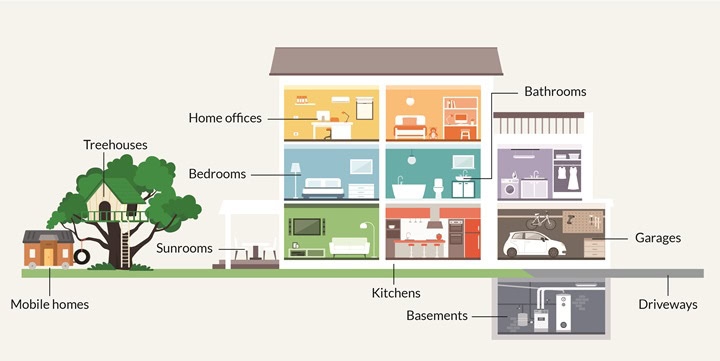
Radiant floor heating systems are versatile and can significantly improve comfort in almost any space. Here are the best rooms to install this efficient heating solution:
1. Basements
Basements typically suffer from cold and dampness. A radiant heating system effectively addresses these issues, making basements more functional as living spaces or recreational areas.
2. Bathrooms
Bathrooms are ideal for radiant underfloor heating. The typically cold tile floors become comfortably warm, making those chilly winter mornings more bearable. Additionally, radiant heating helps maintain a consistent temperature, reducing the dampness caused by showers and baths.
3. Bedrooms
Bedrooms are another perfect option for radiant floor heating. It ensures the room remains warm and inviting, eliminating the need for noisy space heaters or overworked HVAC systems.
4. Driveways
An innovative use of radiant heating is in driveways. Systems installed beneath driveway surfaces prevent ice and snow buildup, making winter maintenance easier and safer. Learn more from the Met Office for safely keeping snow off your driveway.
5. Garages
Installing radiant underfloor heating in garages can transform these often cold spaces into comfortable areas for workshops or even a home gym. It’s particularly useful for melting snow off vehicles in the winter, keeping the space dry and usable all year-round.
6. Home Offices
Working from home has become more common, and ensuring that your home office is comfortable to work in is integral for your performance. Radiant floor heating can make long hours at your desk more pleasant, providing gentle, consistent warmth.
7. Kitchens
Kitchens often feature tile or stone flooring that can be cold underfoot. A radiant heating system in the kitchen not only warms the floor but also helps to moderate the room’s temperature, making it a welcoming space during the autumn and winter months.
8. Mobile and Tiny Homes
For those living in mobile or tiny homes, radiant floor heating provides a compact and efficient heating solution that maintains comfort without taking up precious space. Learn more in our mobile home insulation guide.
9. Sunrooms
Sunrooms (or conservatories) can benefit greatly from radiant heating during the cooler months. It counteracts the cold outside from large, exposed windows, ensuring the room is usable all year round.
10. Tree Houses
Even tree houses can be fitted with radiant heating, allowing these whimsical structures to be enjoyed during cooler weather, extending their use beyond just the warm months.
Myths About Radiant Floor Heating
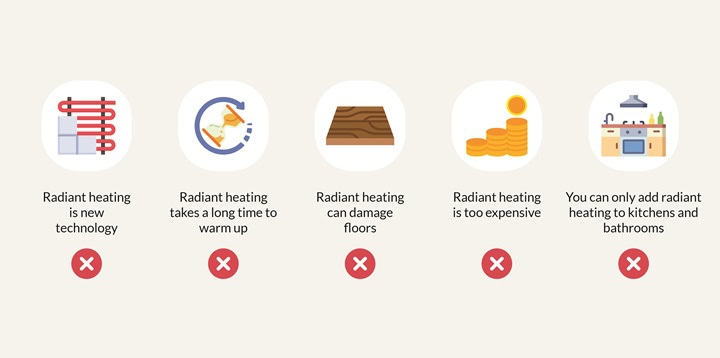
Radiant underfloor heating is surrounded by misconceptions, despite its long history and proven benefits. Here, we address some common myths:
- Radiant heating is new technology: Far from being a modern invention, radiant heating systems trace back to ancient times, and Roman underfloor heating is regarded as one of the first unique designs.
- Radiant heating takes a long time to warm up: Contrary to the belief that they are slow, radiant underfloor heating systems can heat spaces efficiently, often reaching desired temperatures faster than conventional heating systems.
- Radiant heating can damage floors: Proper installation is vital. When radiant floor heating is correctly installed, it poses no risk to your flooring materials, ensuring safe and long-lasting operation. In fact, our guide on the dangers of underfloor heating helps to debunk any concerns you may have about safety with it in your home.
- Radiant heating is too expensive: Although initial installation costs can be high, electric radiant floor heating and water-based systems are more cost-effective over time, especially when considering their energy efficiency and the reduction in maintenance costs.
- You can only add radiant heating to kitchens and bathrooms: It’s a myth that radiant heating is only suitable for bathrooms and kitchens. As shown above, you can add these systems to practically any room and floor coverings.
Radiant Floor Heating For Everyday Homes
In conclusion, radiant floor heating systems are the best alternatives to regular central heating systems for you to try in your homes. Whether you live in new builds, period builds, off grid homes, or other home types, radiant and underfloor heating systems can offer the best solutions. By purchasing a wet or electric underfloor heating system today, you are guaranteeing warmth and increasing property value for your home for the foreseeable future.
As a lead supplier of underfloor heating in the UK, we at Underfloor Heating Trade Supplies are proud to assist with any enquiries you may have about these systems. Contact us today and shape the future of your home today with the right heating system.
Feel free to click below and download our bespoke radiant floor heating infographic!
FAQs
Does radiant floor heating require maintenance?
Radiant floor heating systems generally require minimal maintenance. However, it is recommended to have periodic checks by a professional to ensure the system is functioning correctly.
Can radiant floor heating be used with solar power systems?
Yes, radiant floor heating can be very effectively paired with solar power systems, particularly those that generate hot water, to create solar underfloor heating.
Can you retrofit radiant floor heating in an existing home?
Yes, you can retrofit underfloor heating, though the installation might be more complex and costly compared to new builds.
How does radiant underfloor heating affect indoor air quality?
Radiant floor heating can improve indoor air quality by reducing the circulation of airborne particles, which is common in systems that rely on blowing air through ductwork, provoking heat and asthma.
Sources
Met Office. (2020) Clearing your path or driveway – the snow code. [online] Available at: https://www.metoffice.gov.uk/weather/warnings-and-advice/seasonal-advice/your-home/clearing-paths-and-driveways [accessed 11/07/24]
